
CATEGORIES:
BiologyChemistryConstructionCultureEcologyEconomyElectronicsFinanceGeographyHistoryInformaticsLawMathematicsMechanicsMedicineOtherPedagogyPhilosophyPhysicsPolicyPsychologySociologySportTourism
B) In pairs, tell each other about the films you like.
 LISTENI G
LISTENI G
. ® a) Look at the pictures and say which
r: of the words in the box you would
Use to describe each picture.
attractive, ugly, interesting, beautiful, silly, meaningless
 1-
1-
::J
ID
<{
[!)
z
:1.!
<{
11.1
C.
Ul
Woman's Head with Sombrero
(1962). By Pablo Picasso
Circus Girl (1939).
By Georges Rouault
Icarus (1947).
ByHenri Matisse

 @ ®
@ ®
Landscape by the Sea (1914).
By August Macke
B) Think and say.
Which of the above pictures would you put on walls in your flat?
Which of the pictures do you like the best? Why?
What's the most striking thing about it?
What does it make you think of?
Painting (1937). By Ben Nicholson
 Street Scene (1935). By L.S. Lowry
Street Scene (1935). By L.S. Lowry

LISTEN I
A) Listen to someone talking about the paintings on page 178, than match the paintings (A-F) with the following comments about them (1-6).
1 I'd find it rather disturbing.
2 It's a very warm painting.
3 Suitable for a hall.
4 Interesting for a few moments.
5 I'd grow bored with it rather quickly.
6 A very peaceful painting.
B) Listen again and decide which pictures he would put on a wall in his home.
c) Work in pairs. Check each other's answers.
G 
 Ul
Ul
1'1
)>
"z
[j)
)>
m
c
.;
)>
::0
.;
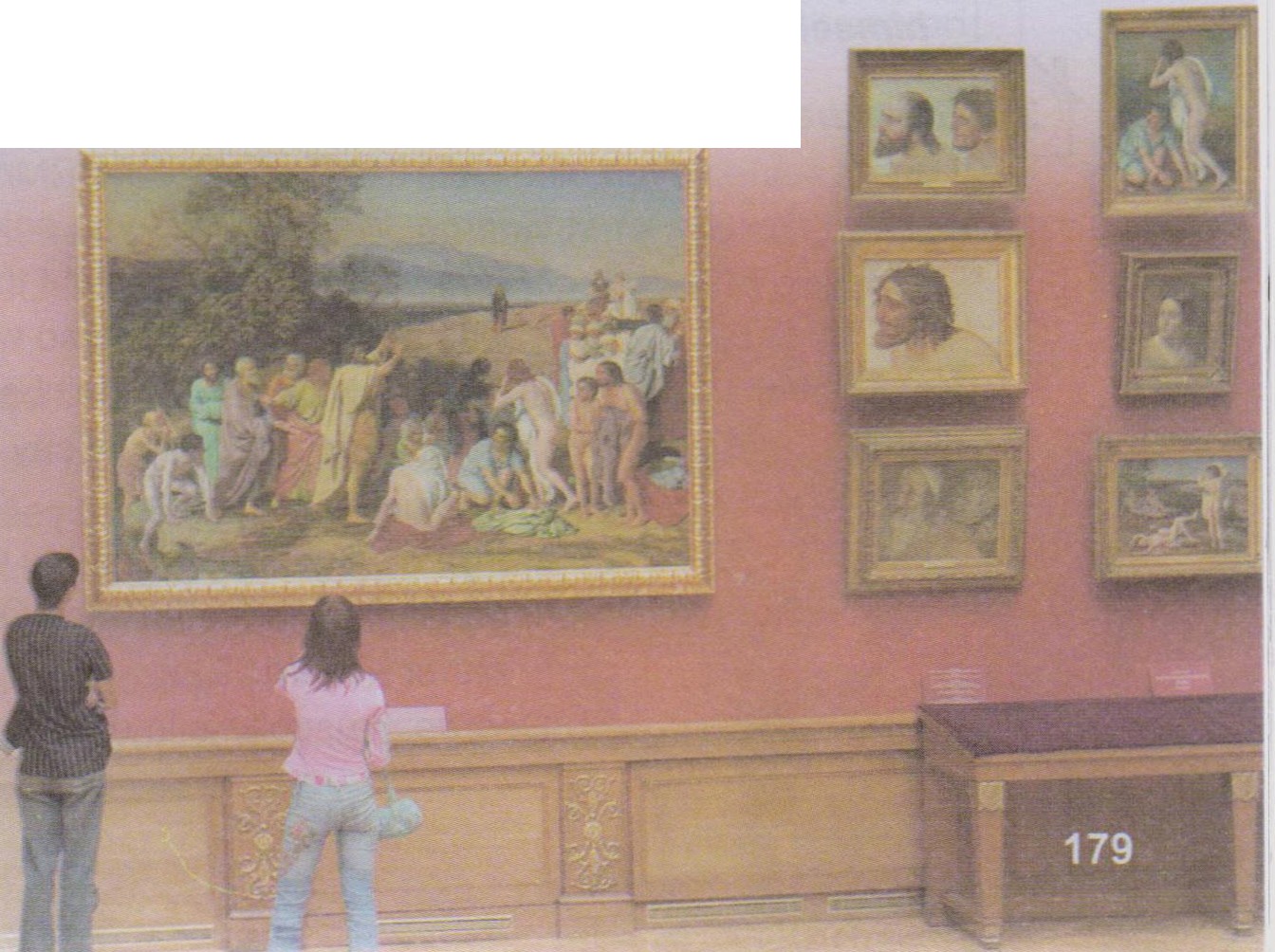
7 In groups, discuss the following questions.
1 Are you interested in any kinds of visual art?
Which of them is closer to you?
2 Would you like to know more about art and its history? Where can you find information about them?
3 Is there an art gallery in the place where you live? What does it exhibit?
How often do you go there?
4 Is there a particular artist whose works you enjoy most? What in this artist's work do you find attractive?
5 Which of the world-famous masterpieces would you like to see some day?
Why?
6 Do you think art should be an essential part of every person's life or it is meant for a selected few?
7 Should art be taught at school? What way?
At what age?
8 Do you think a person's artistic taste is inborn? Is it possible to develop it? In what way can one do it?
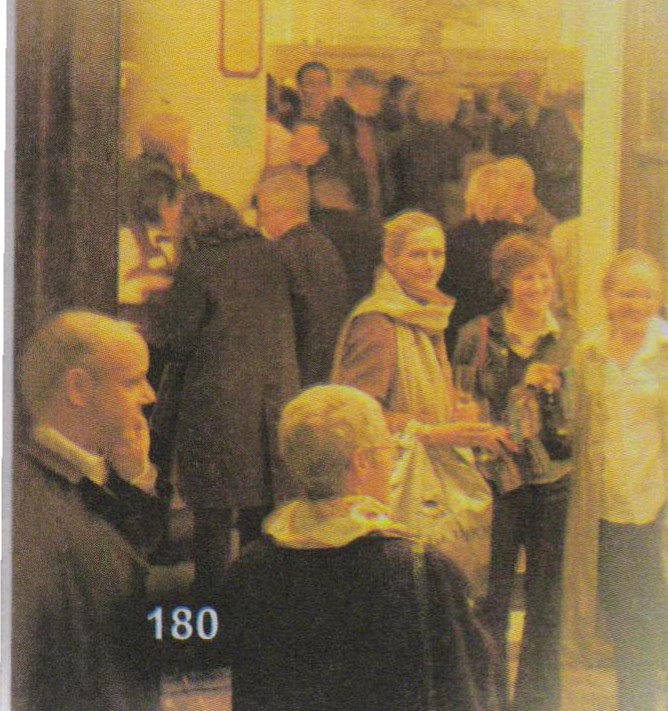
.
<(
1-
::J
III
<(
L!l
z
<( UJ D.
Ul
SPEA lNG
 1 a) Make up a questionnaire using the clues below.
1 a) Make up a questionnaire using the clues below.
1 you I enjoy I going to the theatre
2 how often I you I go to the theatre
3 how many times a year I you I go to the theatre
4 which I be I your favourite performance or show
5 you I enjoy I going to the cinema
6 how often I you I go to the cinema
7 which I be I your favourite film
8 you I enjoy I watching home videos
9 how often I you I watch videos I at home
10 which I be I your favourite video film 11 you I enjoy I watching TV films
12 how many times a week I you I watch TV films
13 which I be I your favourite series or a soap opera 14 you I enjoy I going to pop concerts
15 which I be I your favourite pop group or singer
16 how many times a month I you I go to a pop concert 17 you I ever! be I at a concert of classic music
18 you I like I it
19 you I ever I be I at the opera house
20 how many times a year I you I go to the ballet or opera
b) Work in pairs. Use your questionnaire and ask each other about your favourite entertainments. Make notes. Tell your classmates about your partner's favourite performances and performers. Say how often he/she goes out to entertain himself I herself.
@Read the dialogue. Then make up a similar one and dramatise it in pairs.
AFTER THE PERFORMANCE
George: Well, how did you enjoy the play, Margaret?
Margaret: Oh, enormously! I thought the production was really brilliant, and so was the acting.
George: If Nickolson hadn't been ill, it would have been even better. They say he's wonderful in the part of the inspector.
Margaret: But his understudy was very good too, particularly in the last act. Of course, the plot was rather absurd ...
George: It usually is in detective plays.
Margaret: Take the wife, for instance. She didn't behave like a normal human being at all. If she had only owned uptoherhusband, he would have settled the whole business in no time.
George: But she was supposed to be a dumb blonde. And if she hadn't been, there wouldn't have been a plot, would there?
Margaret: And you know, there wouldn't :· w o R o
have been a second murder if the ·' ,.. F1 LE
inspector hadn't told everybody artistry['a:tlstri]
about his plans. craftsmanship['kra:ftsman)l p]
George: But then the audience would a failure['feJ!ja]
have had to go home at the end of insight['msaJt]
the first act. performance[pa'b:mans]
Margaret: Then take that episode with a shape[)e!p]
the revolver. If he had had any sense, to confess[kan'fes]
U1
1l
1"'1
>
"z'
(jl
>m
c:
-i
>
::0
.
he would have told his wife about the gun instead of trying to hide it.
contemporary[kan'tern prari]
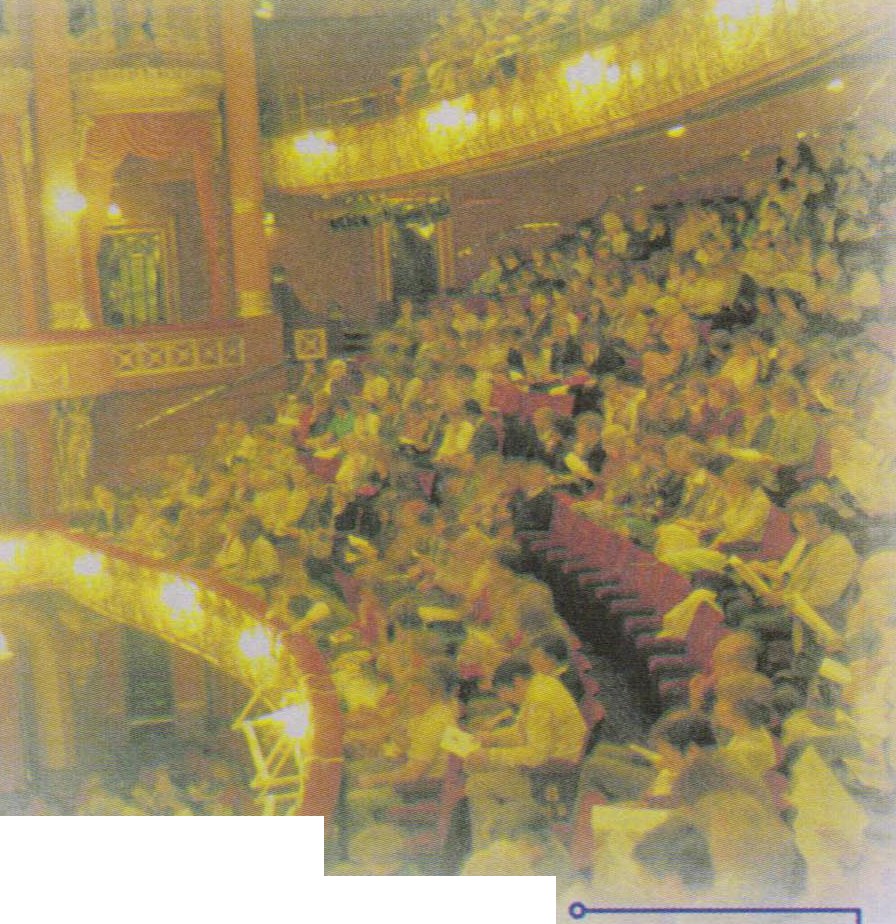
 George: It's a pity you didn't write the play, Margaret. If you had, you would have made a much better job of it. The wife would have confessed to her husband, he would have told the inspector, and there wouldn't have been any corpses. A much better play altogether. Not a thriller, of course ...
George: It's a pity you didn't write the play, Margaret. If you had, you would have made a much better job of it. The wife would have confessed to her husband, he would have told the inspector, and there wouldn't have been any corpses. A much better play altogether. Not a thriller, of course ...
(3) a) Change the following sentences into the opposites.
1 They say his new play is a complete failure with the public.
2 Everybody agrees that X. was at the worst yesterday.
3 This play is still on at the Art Theatre.
4 My friend said that he had enjoyed every minute of the play.
5 N.'s acting was true to life.
6 When one sits on the front rows one has a good view of the performances.

 SPEAKING
SPEAKING
b) In pairs, study the advertisements below and discuss what you
would choose to see. Use some of the sentences you wrote in (a).
182


 This innovative programme features a charming mix of the modern and the classic. Antony Tudor's brilliant choreography unites with Arnold
This innovative programme features a charming mix of the modern and the classic. Antony Tudor's brilliant choreography unites with Arnold
Schoenberg's moving score to create Pillar of Fire, an intense psychological
first performed in 1942. Also on the programme is the smash hit
Within You Without You: A Tribute to George Harrison, featuring the music by the late, great Beatie, George Harrison, and riveting choreography by Natalie Weir, Stanton Welch, David Parsons and Ann Reinking.
Ul
11
1'1
)>
7\ z Gl
)> ID 0
c
-1
)>
;tl
-1
LADY IN THE DARK
a musical play by Moss Hart
| andm |
USIC by Kurt Weill ( 1941)
Moss Hart collaborated with Ira Gershwin and Kurt Weill to
rodu?e his wittiest and most '?ven.tlve work. This is the first
tJme Jt has been staged in Lond
on.
Fashion magazine editor L'
Ell' IZa
Jott Maria Friedman), a woman
struggJmg to balance her career and personal life, visits a psychiatrist in an effort to res I her f elings of indecision and ;e
exp,lam the extraordinary dreams shes been having about her me . Kendall Nesbitt (Paul Shelley), h;; lover and professional patron. Randy Curtis (Steven Edward ,
Moo e), a glamorous, but shallow, mov e star; and Charley Johnson
(Adnan Dunbar), a cantank
ad rt' . erous
ve Jsmg manager.
| s |
nestrations original ore J{urt weill
d for smaller
adapte rnble bY ense ·es 'ferrY pal'l
·ssion of
. 1 perrl11
bY specia 'II roundauon
 tne J{urt Wei sic Director
tne J{urt Wei sic Director
tor Mu rrell
ptatk"' [)O
auinllY sackS
cast
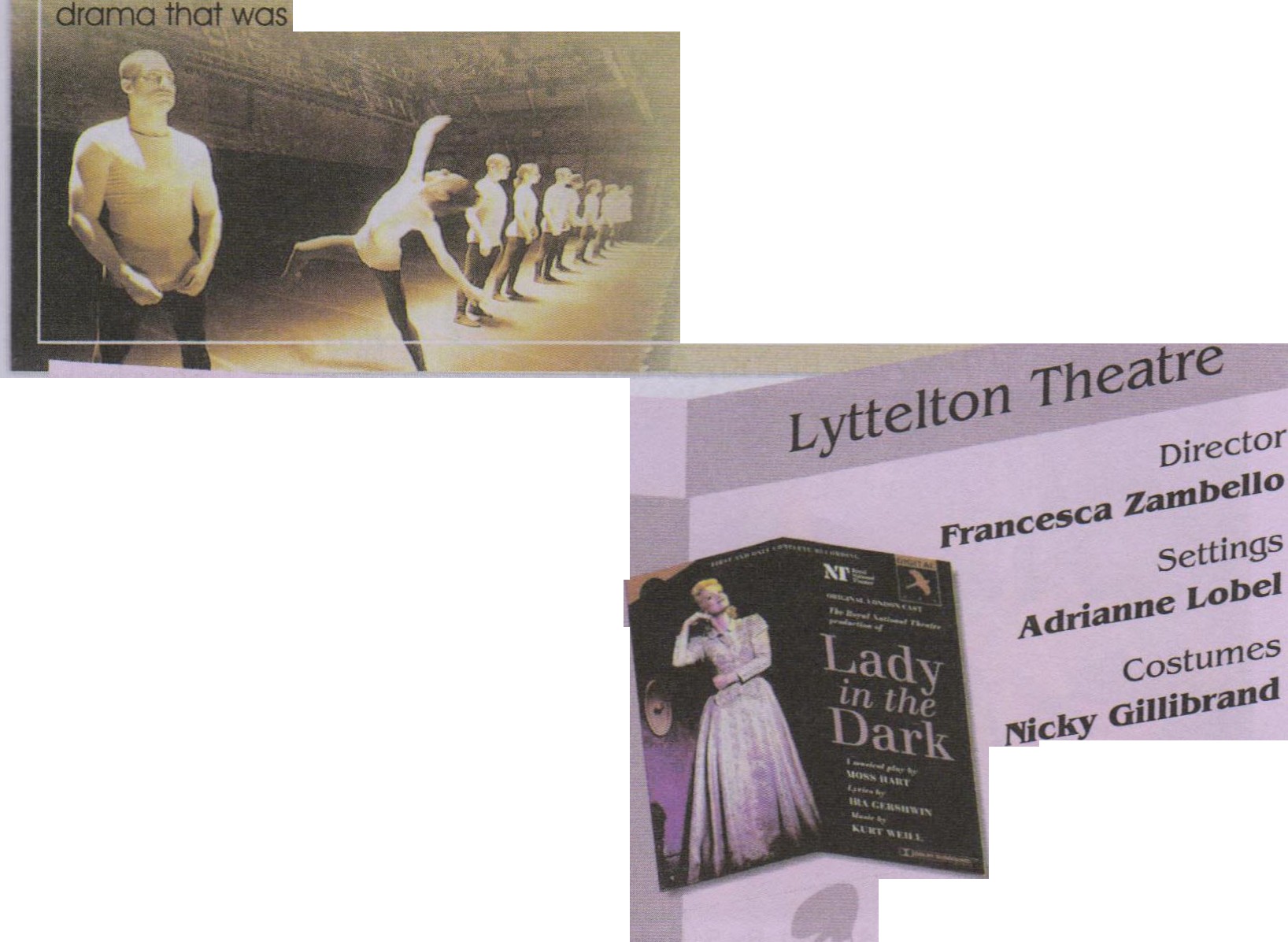

 SPEAKING
SPEAKING
8 a) Look at the works by Ukrainian painters and
...,: say in what genres they are painted.
a:
O(
1-
::J
ID
<
| - |
z
:i
o( w a.
m
Three Ages . By F. Krychevskyi
Porlrait of Hanna Zakrevska .
By T. Shevchenko
 A Town. By S. Rybak Water-mill. By V. Shtenberg
A Town. By S. Rybak Water-mill. By V. Shtenberg
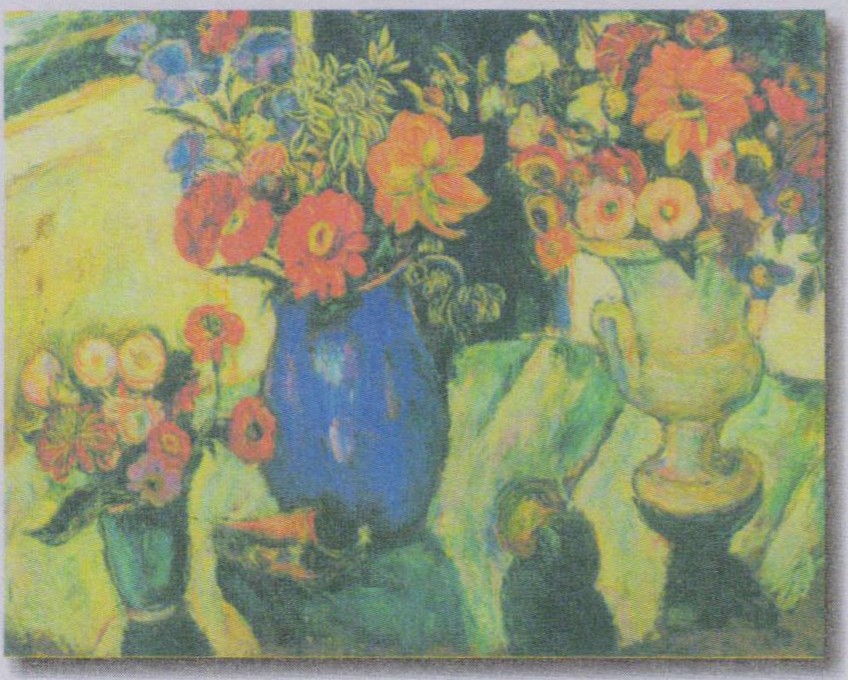 Still-life. By A. Manevich
Still-life. By A. Manevich
The Bridge. By 0. Ekster

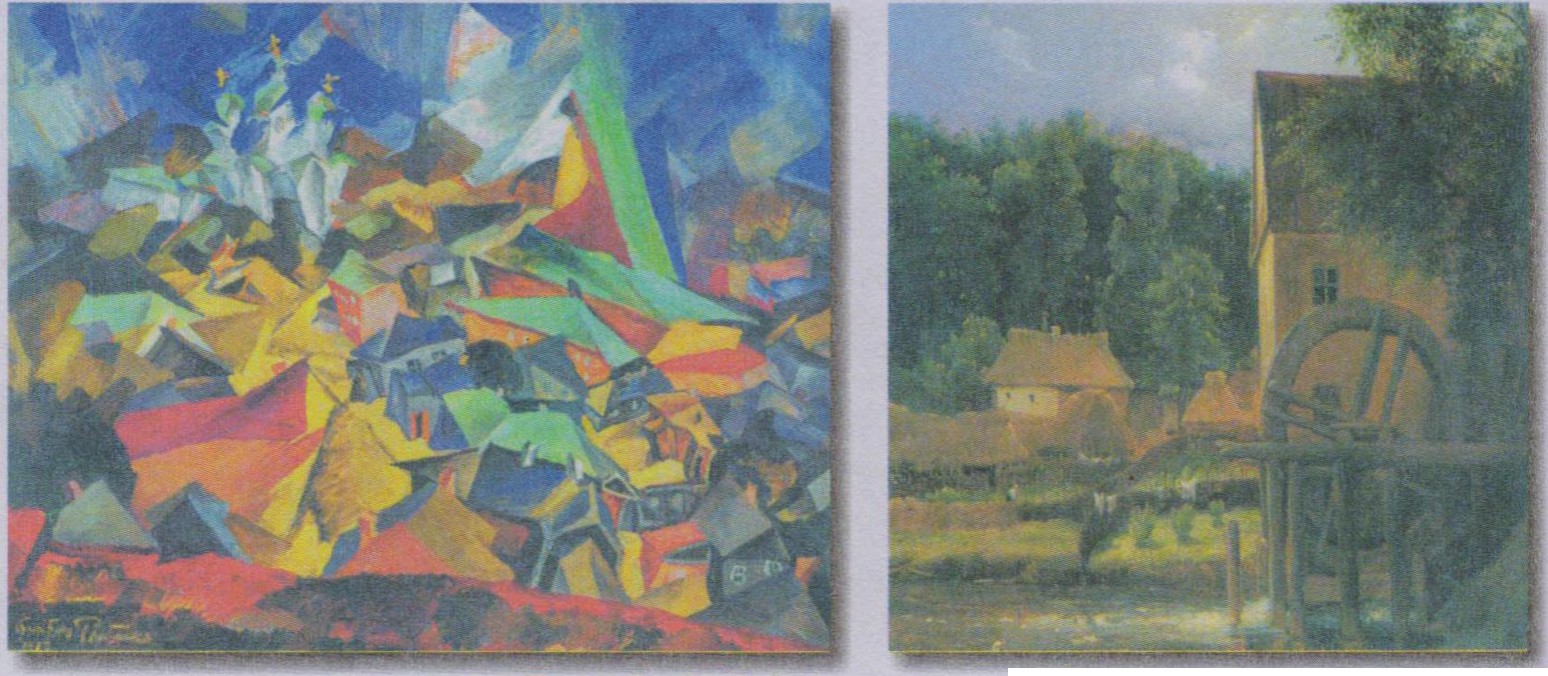
SPEAK NG
b) Work in groups. Speak about each picture. Use the phrases from the 'Useful Phrases' box below. Don't forget to mention:
the subject (what is represented or depicted unit)
the composition (how the space of the picture is used)
the colours {how different colours are handled)
the details (what are they and how they are related to the subject)
the general impression the picture makes
USEFUL PHRASES
Some helpful words and phrases to describe a picture :
the space of the picture is symmetrically I asymmetrically divided;
in the foreground I background I far distance;
the shapes echo with each other I contrast each other;
the picture is painted in warm I cold co1ours;
the dominating colours are ...;
the colours are bright, pale, brilliant, intense, luminous, soft, pure, pastel, delicate, etc.;
the colours contrast with each other I blend together;
the sitter I model .
These words describe a positive impression of a picture:
a masterpiece that can (could) stand the test of time;
a romantic, lyrical, charming, appealing, powerful , original, outstanding painting ;
the artist demonstrates a great sense of space, a real talent as a
colourist, precision of drawing;
the artist managed to capture the sitter's expression, the atmosphere of the place, the mood of the moment.
(5) In groups, speak on the statements (1-6). Highlight the following points about each of them:
What does it mean?
Do you agree? Why (not)?
1 It's hard to overestimate the role of art in one's life.
2 Art forms our outlook and enriches our inner world .
3 Art has a great educational significance.
4 Art brings people up - makes them more humane and kind.
5 Art holds up people's spirits in the tragic moments of their lives.
6 The language of art is universal.

In 1l1"1
)>
z
C1
)>
m
c
-1
)>
;n
:-t

It
<(
1-
:::J
m
<(
L!l
z
:----=- w<(
A.
Ul
USE YOUR E GLISH
'1' Complete the text with the words from the box.
surrealists, realistic, Cubism, emotions, effect, shapes, arrangement, images, colours, scenes
 In European art in the late 18th and early 19th centuries there appeared a group of artists who followed their feelings and (0) emotions rather than logical thought or reason, and who preferred wild, natural beauty to things made by man. Realism followed Romanticism in the 19th century. (1) ... paintings show things as they really are, as they appear to most people. In the 20th century there appeared such art movements as Impressionism, Surrealism, such styles as (2) ... and Expressionism.
In European art in the late 18th and early 19th centuries there appeared a group of artists who followed their feelings and (0) emotions rather than logical thought or reason, and who preferred wild, natural beauty to things made by man. Realism followed Romanticism in the 19th century. (1) ... paintings show things as they really are, as they appear to most people. In the 20th century there appeared such art movements as Impressionism, Surrealism, such styles as (2) ... and Expressionism.
Impressionism was founded in France in the 1870s by Claude
Monet and his friends. They painted outdoors and developed a sketchy, 'impressionistic' style, trying to capture the changing (3) ... of natural light.
Surrealism appeared in the 20th century. Salvador Dali ['da:li] and Rene Magritte ['renet md'gri:t] were famous (4) .... In their works they used strange dreamlike (5) ....
Pablo Picasso became one of the most famous modern artists, working
in many different styles from delicate pastels to striking Cubist (6) ... where he wasn't trying to create lifelike pictures. He distorted space and broke things up into angular (7) .... This style became known as Cubism.
At the beginning of the 20th century in Germany there developed a style
known as Expressionism. Expressionist artists use exaggerated shapes and
(8) ... to try to convey feelings, as in the works of Edward Munch [mook].
Abstract art became popular in the 20th century. It doesn't mirror real people or things, but is an (9) ... of shapes and colours.
@ Complete the text with the appropriate participle forms of the verbs from the box.
 see, crawl, be tired, try, dress up, find, whisper,
see, crawl, be tired, try, dress up, find, whisper,
lose, check, feel, cry, draw, push, be
AN ACTOR IN A ZOO
One day an actor went to the zoo, and while (0) being there, he tried, (1)
... his job the day before, to earn some money as a street performer, (2) ...
his artistic skills at the same time.
A crowd, (3) ... by his performance, started to gather around him. (4) ... that, a zoo manager invited him into his office. The actor was offered a job, to take the place of their lost gorilla.
The next day, (5) ... as a gorilla, he was entertaining visitors, (6)
... to catch a glimpse of his show.
After a while, the crowd, (7) ... of his jokes, turned to the tiger's cage, next to his own. (8) ... envious, he began teasing the tiger. The tiger, absolutely
USE YOUR ENGLISH
G
IJl
ll
J1l
)>
A
z
G1
)>
m
c
-i
)>
;u
:-1
furious, grabbed him (9) h' . .
. · ··· rmself rn a trger's cage he had
orgotten hrs role, (10) ... for help and (11) t
gate. ' ... owards the
| quret. |
hrm (13) "K
' ... eep
. 1 Do you want us to lose our
ove jobs?"
Comment :m the quotations. Say which of them you agree or d1sagree and why.
There is nothing but art. Art is living. To attempt to give an object of art life by dwelling on its historical, cultural or archaeological association is senseless.
(W. Somerset Maugham 'The Summing Up')
The true function of art is to... edit nature and so make it coherent and lovely.
(H. L. Mencken)
One is never tired of painting, because you have to set down, not what you knew already, but what you have just discovered.
(William Hazlitt 'The Pleasure of Painting')
Art is long and life is fleeting.
(H. W. Longfellow)
The perfection of art is to conceal art.
(Quintilian [kwm'tlh;}n])
All art is but imitation of nature.
(Seneka)


187
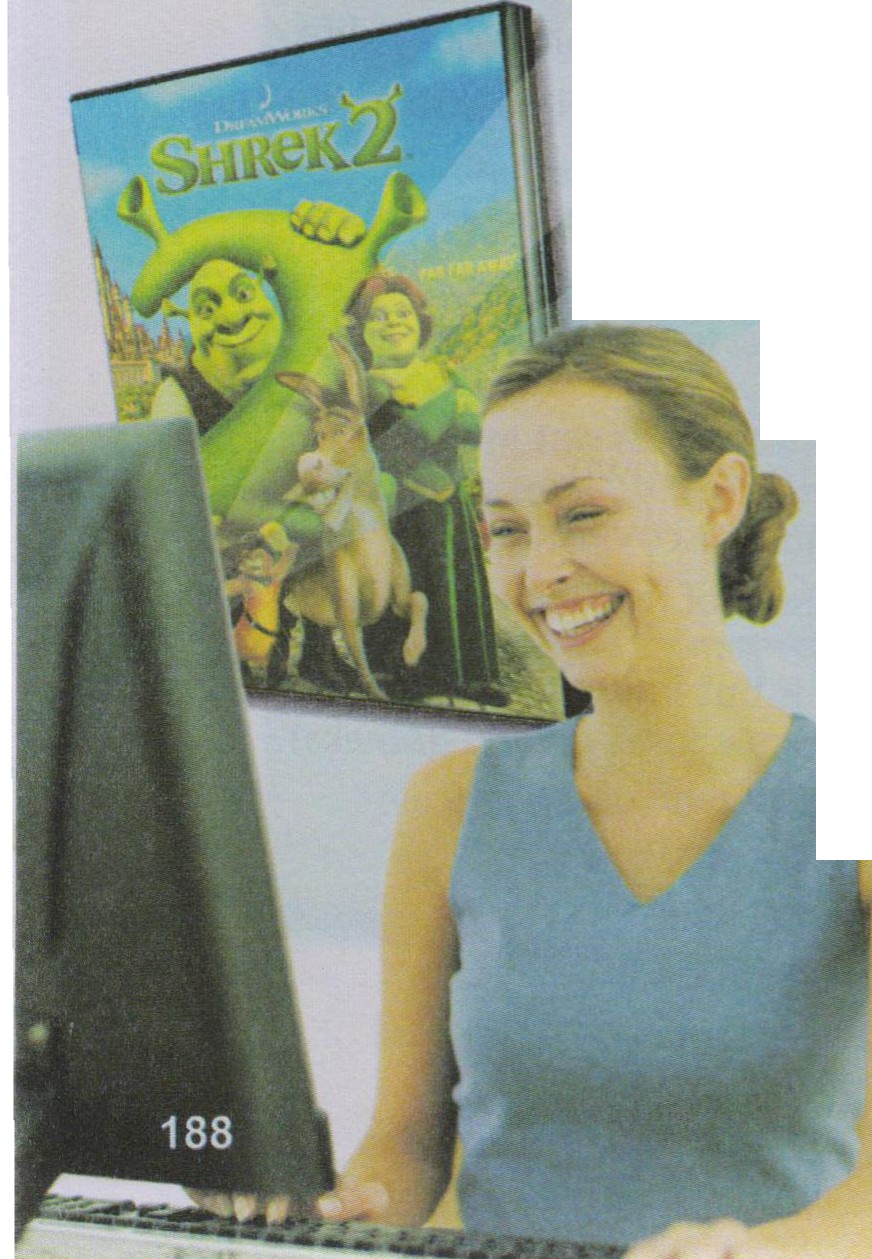
 .
.
...:
It
<
1-
:::J
TD
<
| z |
-
<w
D.
U1
U YOUR E GLI H
4 ) Work in pairs. Read the email. Find answers to all the questions after it.
 Hi,
Hi,
I saw Shrek 2 for the first time yesterday. Loved it. It's about an ugly but lovable green ogre -that's Shrek -who's married to an ugly but lovable green Princess Fiona. They live in a swamp , but they go to see Fiona's parents in the Kingdom
of Far, Far Away, which is really like a cross between Los Angeles ,
Hollywood and Disneyland . The king cannot accept Shrek as a son-in law, and Shrek decides to drink a magic potion1 to make him handsome and Fiona beautiful. There's also a nasty Fairy Godmother and a horrible self-centred but fantastically handsome Prince Charming , her son, who wants to take Shrek's place and become Fiona's husband . In the end, of course , Shrek and Fiona end up together , as ugly as ever.
I think the point of the film is that if you love someone , it doesn't matter about the colour of his I her skin or look. When Fiona thinks that Prince Charming is Shrek , she can't fall in love with him, even though he is so fantastically good-looking. What matters is the character of the person.
You know, in most Hollywood films , everyone is so good-look ing, and it
is really nice to have main characters who are ugly. And althougb we live in a culture where everyone wants to be beautiful, when watching the film you don't want Fiona and Shrek to change
-you want them to stay the ugly people they are.
And the film's great fun -full of humour. Especially the Donkey (Eddie Murphy's voice) . And visually it's brilliant.
The animation is unbelievable. It was directed by Andrew Adamson . Although it's a cartoon , the
facial expressions of the cartoon characters are very realistic and believable -even the Donkey's. So there were
plenty of moments where I had a good laugh, and the film leaves you with a smile on
your face. I'm sure you'll really like it.
Shall I lend you the DVD?
See you ,
Mandy
1a potion ['peojn] -,Q03a niKiB (0Tpyn1) ; 3ii1Ilfl
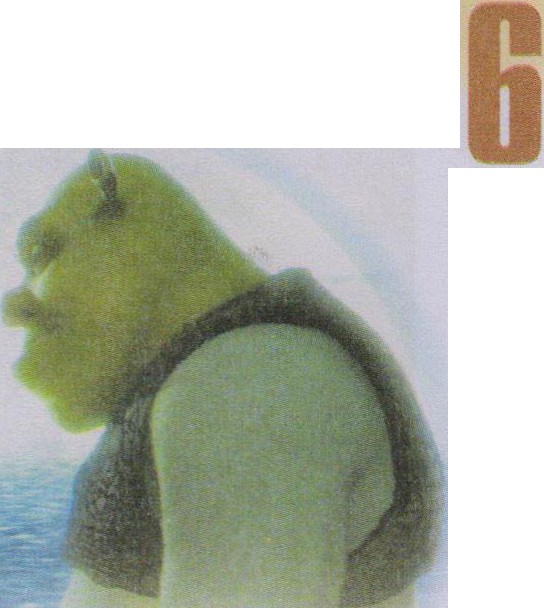 USE YOUR ENGLISH
USE YOUR ENGLISH
Who is the director?
 What is the title?
What is the title?
What genre does it fit?
Who are the main characters?
What are they like?
What is it about, in general?
What issues does it raise?
Did you like it in general? Why?
How did the film affect you?
Are the actors good in their parts? Why or why not?
Is it interesting, memorable, entertaining? Why?
What specifically did you like I dislike? Why?
Did you agree with the main theme I purpose? Why or why not?
Did the director do a good job? Why or why not?
Would you recommend the film to your friends? Why or why not?
5 Imagine you are a film critic. Choose the last film you saw and follow the instructions. Work in groups.
1 First, give the title and the genre. Mention the director, actors, special effects, duration, country of origin (British, Italian, French), etc.
2 Tell the story. What is the film about? Who are the characters? What happens in the film?
3 Give your opinion- why you like I don't like the film.
4 Recommend I don't recommend the film.
6 Work in pairs. Complete the dialogue with the sentences from 1 to 7 (see the next page) and dramatise it.
A: How did you like your visit to the gallery?
DB: .............................................................................................................. .
A: Yes, it's a fine collection, of course. I am sure that a lot of pictures drew your attention. Are there any pictures that you especially liked?
DB: .............................................................................................................. .
A: Try to describe the picture. Perhaps, I will help you.
DB: ............................................................................................................. ..
A: Are there people in the picture?
DB: .............................................................................................................. .
A: Oh, yes, I know! And a shepherd boy in the distance ...
DB: .............................................................................................................. .
A: And in the background you see two village houses with smoke coming out of chimneys.
In '1l 1"'1
>
z
L.i1
>
m
c:
-1
>
::0
.
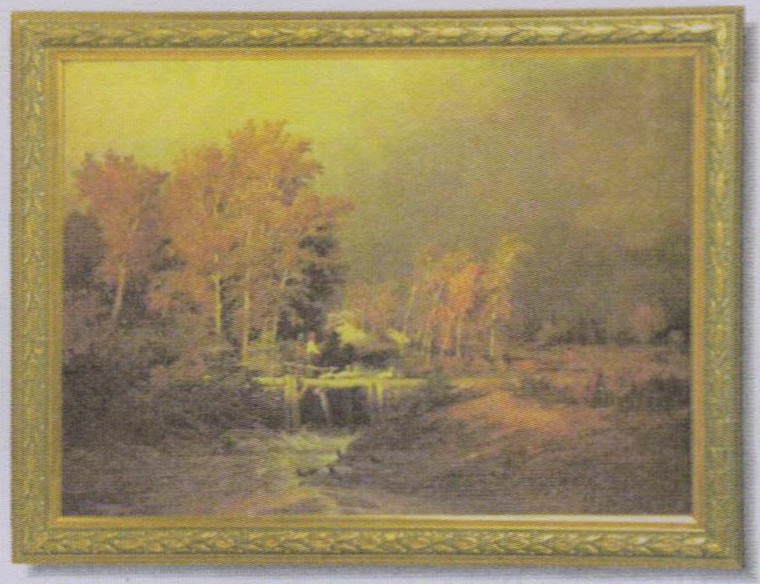 DB: ...................................................... .
DB: ...................................................... .
A : It's a picture by an outstanding
ll
<(
1-
:J
ID
<(
[!)
| - |
!I£
<(
w
a.
Before the Rain. By Feodor Vasiliev
Russian painter of the 19th century Vasiliev. The picture is called Before the Rain.
DB: ................................. ......................
A: Vasiliev was very talented, and his work is distinguished by a roman tic perception of life and nature.
!I)
1 Well, it's really difficult to choose among such a lot of masterpieces of
world painting . But I remember being charmed by one landscape. It depicts the approach of a thunderstorm and is painted with great talent. The artist was able to impart a sinister atmosphere of the coming storm.
Only I can't remember what the picture is called or the name of the painter.
2 Oh, I enjoyed it. I have never seen such a rich collection of Russian painting.
3 That's right.
4 Well, it's a forest scene. The time is late summer or early autumn. Many leaves on the trees are already of reddish-yellow colour. A threatening cloud covers the sky. You get an impression that the next moment it will start raining.
5 The landscape in the picture looks very romantic.
6 Yes. The artist enlivens the landscape by two women driving geese along a little wooden bridge cross a stream in the foreground ...
7 Yes.
'7 Role-play the situation in pairs.
 You and your friend want to visit an exhibition of pictures. Discuss with him/her which one of the options below is the best place to go.
You and your friend want to visit an exhibition of pictures. Discuss with him/her which one of the options below is the best place to go.
an exhibition of pictures by Ukrainian artists of the 19th-20th centuries and avant-garde works
USE YOUR ENGLISH
an exhibition ofT. Shevchenko's paintings and drawings
an exhibition of the Ukrainian folk arts of the 15th-20th centuries
an exhibition of the Italian Renaissance of 17th-18th centuries
You begin the conversation and have to decide on which option (only one) to choose . Remember to:
1 discuss all the options;
2 take an active part in the conversation and be polite;
3 come up with ideas;
4 give good reasons ;
5 find out your friend's attitudes and take them into account;
6 invite your friend's attitudes and take them into account ;
7 invite your friend to come up with suggestions ;
8 come to an agreement.
8' In groups, discuss the following items.
1 What makes good art? Do you think art can be great if it is not linked with the people's lives, their interests and ideals? Give your reasons .
2 How does art help us understand the outside world?
3 What purpose does true art serve?
4 Share your opinions: Real art appeals to the heart and mind of man,
to his feelings and ideals and it proclaims life. Art is life, pretence of art is death.
5 True art elevates the mind and the soul of the people . ·
191Do the project 'A Gallery of Compositions' and write about your vision
Nof art's role in modern society. Follow the instructions below.
1 Read what is said by Carolyn Wardle about art and its functions and think if you agree or disagree. Decide if you agree with all the points or only with some of them.
''_Art !Jhou!J entertain. .Jt !Jhou!J efevale the heart and the mind. .Jt !JhoufJ poke fw/e!J in t/w 6Ander!J o/
!Jociety. 1_}et, even after it ha!J done the!Je three thirup,
art flhoufJ o//er one more import nt /eature.
_AnJ that ij to pronwte Ji!JcuJ!Jion which wtff acl a!J a cata jt /or change. "

IJl 1l111
>
i\
z
Gl
>m
c
-i
>;o
;-!

| G |
<1:
1-
::J
m
<(
[!]
z
<1:
| n. |
Ul
USE YOUR ENGLISH
2 Think what you are going to add in order to expand the information from the quotation by giving your own examples and opinions and making a general comment on the subject. Draw a spidergraph of the ideas you are about to develop in your composition, if you find it helpful and necessary to do.
3 Write a list of expressions, which may be useful when you are going to express agreement or disagreement in your composition.
4 Write a draft copy of your composition. It should contain about 90 words.
Check it carefully for grammar and vocabulary mistakes. Look also at how you have expressed and justified your opinion. Look at how your ideas are expressed (if it is clear what you want to say or not) and organised in the paragraphs.
5 Make all necessary corrections and write a neat copy of your composition.
6 In a group, arrange a gallery of works. Compare your composition with one or two works of your classmates and make judgemene on the following.
Whose composition is the most interesting one for the reader?
Whose thoughts and ideas expressed in it are the most original ones?
Whose ideas are expressed and organised in a very clear and thoughtful way?
Who is the best at finding examples to support his or her point of view?
Who has made no or only few grammar or vocabulary mistakes?
Whose spelling is the best one?
What are the strong and weak points of each of you as a writer?
7
| ------------------ |
18 judgement ['dy,d3m<mt]-
cyA>f(eHHSl

 WRITING
WRITING
G) a) Read the information and put 6-8 questions to it.
Reviewsare brief descriptions of books, films, COs, TV programmes, etc. They can be either formal or semi-informal in style , depending on the type of publications they appear in and who the target readers are. They are published in newspapers, journals, periodicals or magazines.
The purpose of a review is twofold: to inform readers, viewers or listeners, and to express an opinion or recommendation about a book, a film or a TV programme. Therefore, reviews not only describe, but also evaluate books, films, TV programmes or COs.
A review usually consists of:
an introductionwhich briefly states all the background information concerning a book I film I TV programme , etc. (the title, the type, the author or director, the theme, main characters, etc.);
a bodyconsisting of two or more paragraphs giving an outline of the plot (you should NOT under any circumstances reveal the end), including an evaluation of and comments on various features, such as the direction, acting, cast, main characters, plot, sound effects, screen play, special effects, music, etc., or to put it briefly, all the good and bad points of the film, book, etc.;
a conclusionwhich includes a general assessment and/or a recommendation supported by relevant reasons.
We often use present tenseswhen reviewing a film, a book, etc. to make the description vivid and lively. We also use a variety of adjectivesto make it more interesting and appealing to the reader.
b) Work in pairs. Role-play the interview between a professional critic and a journalist who is interested in what a good review is. Use your questions and the information above.
0Match review parts (1-3) with their contents (a-c).
1 Introductory paragraph achronological outline of the plot with
2 Body paragraphs an evaluation of various features
3 Concluding paragraph bgeneral assessment and/or possible
recommendation with justifications
cstating all the background information

Ill
1'1
| - |
7\
z
LiJ
)>
m
c
-f
)>
| . |
:-1

..:
1l
<
1-
:::J
WRITING
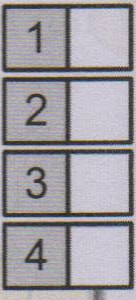
 0Put the parts of the review below into the correct order.
0Put the parts of the review below into the correct order.
The film is everything what most of others are not. It is deep, sincere and magnificent. Make sure you don't miss it.
m
<
[!)
!ll
<w
a.
@ Beautiful Mind' (USA, 2001) is impressive drama with great success. award for the best movie.
| - |
 © ral is perfect. 1 recommend this film to everyone. It doesn't matter if you like drama or not because this film will simply fascinate you.
© ral is perfect. 1 recommend this film to everyone. It doesn't matter if you like drama or not because this film will simply fascinate you.
@ The story is set in Princeton in 1947. John Nash is incredible strong performance of Russell Crowe. He is brilliant and young mathematical genius. Three years after finishing university he
becomes victim of mystical conspiracy His devoted wife, convincing Jennifer Connelly, is the only person who can help him in this extremely powerful realisation about courage, passion and triumph.
a)  Work in pairs. Choose a film you like and make notes sing the following headings and prompts.
Work in pairs. Choose a film you like and make notes sing the following headings and prompts.
Introduction (background) .··········································································· Title··············································································································
= - ?·:::::::::::::::::::::::::::::::::::::::::::::::::::::::::::::::::::::::::::::::::::::::::::::::
Director?······································································································ Main Character I Starring? ··········································································
Plot·············································································································· When I Where? .........··················································································· Main Character I Cast ................................................................................. .
Outline········································································································· Opinion········································································································ General Assessment-Recommendation ..····················································
WRITING
Date: 2016-03-03; view: 3178
| <== previous page | | | next page ==> |
| Put the verbs in brackets into the Present Participle or Past Participle. | | | B) Role-play the situation in pairs. |